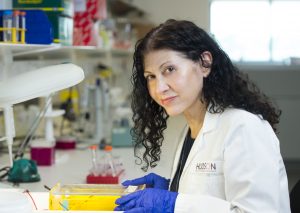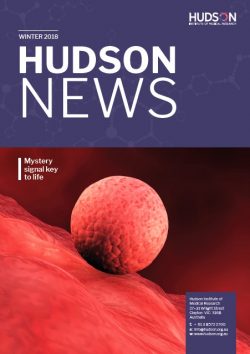Women and couples in Australia and New Zealand now undergo more than 70 000 IVF treatment cycles each year in the hope of starting a family or having more children.

Around a third of couples who undergo IVF will have a baby as a result of their first cycle. This rate increases to 54 to 77 per cent by the eighth cycle.
Yet, for many of the couples affected by infertility, the embryo fails to attach to the lining of the uterus or the woman miscarries at 6 to 12 weeks, causing significant heartache, as well as financial strain.
Despite advances in IVF technology, the reasons why some embryos fail to latch onto the cells in the womb remain unknown.
“Repeated implantation failure or recurrent miscarriage can be devastating,” Professor Eva Dimitriadis, Head of Hudson Institute’s Embryo Implantation laboratory, explains.
“It’s thought that around half of all embryos that fail to implant are chromosomally abnormal. The other 50 per cent – we don’t know why they fail. It’s a mystery.”
Now, Prof Dimitriadis’ research is offering hope by intercepting an embryo’s subtle cues to the body.
The team has identified a small molecule, released by a human embryo in the womb, which could be the key to understanding why some embryos fail to implant.
In a study published in the Reproduction, Fertility and Development journal, Prof Dimitriadis found that the pattern in which this message, or small molecule called microRNA-661, is released to a woman’s body reflects whether or not the embryo will implant during IVF.
Her team also showed that this small molecule regulates the way an embryo attaches to the cells that line the uterus.
Next steps
Prof Dimitriadis says the finding could help IVF clinicians to select embryos that are most likely to result in a healthy pregnancy, or to create the ideal environment for a pregnancy when an embryo is transferred to the womb.
“Often embryos look normal, yet they don’t implant,” Prof Dimitriadis explains.
“Now that we are beginning to understand how fertilised eggs ‘talk’ to the womb, we could help IVF clinicians to choose the embryos with the best potential to implant, and help more women to achieve a successful pregnancy.”
Clinical collaborator, Professor Luk Rombauts, Group Medical Director of Monash IVF, says, “We are learning more and more about how to select the best embryo for implantation but it has remained hard to determine when the womb is ideally prepared for its arrival.
“Our research collaboration with Prof Dimitriadis is starting to unravel the dialogue that happens between the embryo and the womb. That is important because it can help us find more successful strategies to help IVF patients fall pregnant.”
FERTILITY / IVF FACTS
• Infertility affects about one in six couples in Australia.
• 77 721 IVF cycles were performed in Australia and New Zealand in 2015.
• 14 791 babies were born from assisted reproductive technologies including IVF in 2015.
Did you know?
During the 1980s, Hudson Institute Distinguished Scientist, Professor Alan Trounson and his colleagues developed groundbreaking IVF technologies including the use of fertility drugs to time ovulation, systems for egg collection and embryo donation and techniques for egg and embryo freezing. More than seven million babies around the world have been born as a result of these technologies.
-
Next
Director’s message

